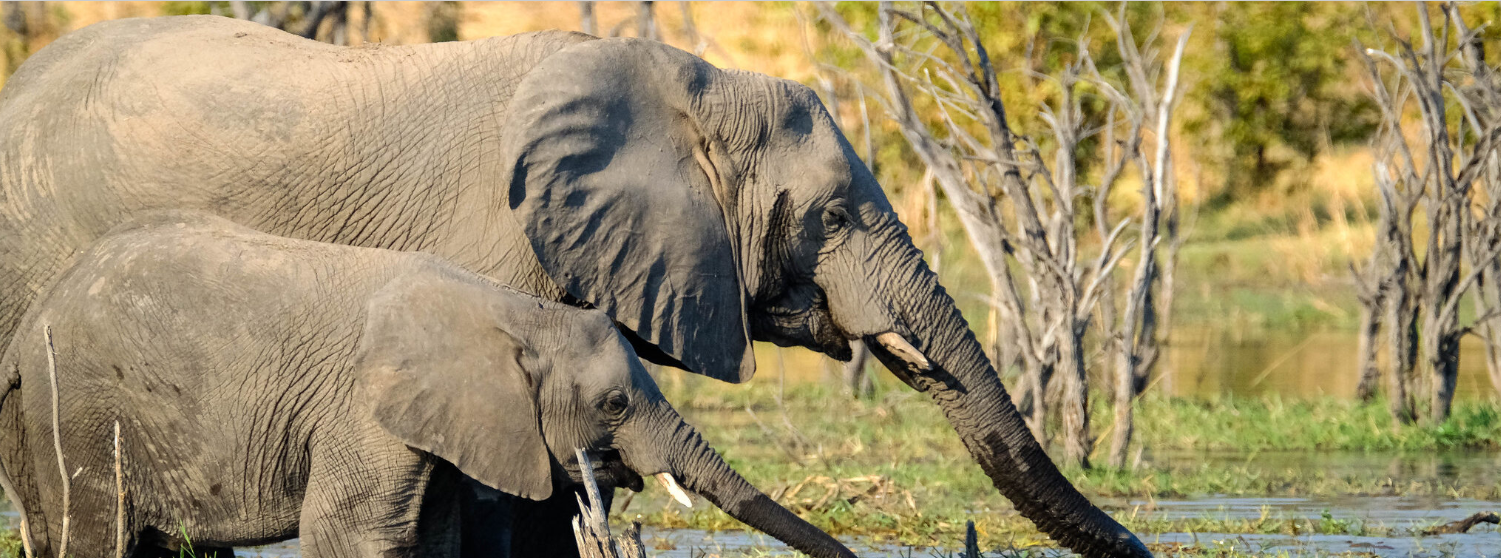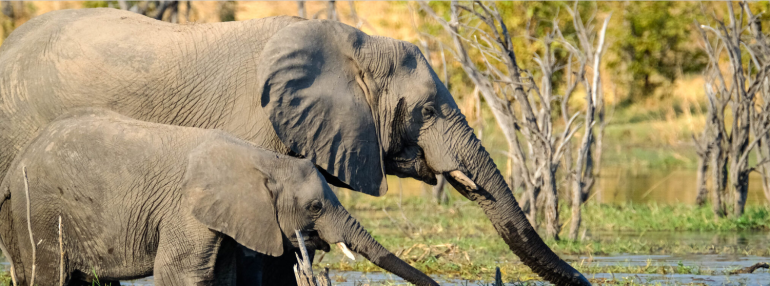Omanyano ovanhu koikundaneki yomalungula kashili paveta, Commisiner Sakaria takunghilile
Veronika Haulenga
Omanyano ovanhu koikundaneki yomalungula kashili paveta, Commisiner Sakaria takunghilile
Veronika Haulenga
Listeners:
Top listeners:
-
play_arrow
Omanyano ovanhu koikundaneki yomalungula kashili paveta, Commisiner Sakaria takunghilile Veronika Haulenga
Analysis of largest elephant surveys ever shows stable population, but disturbing trends


- New research comparing data from the two largest-ever elephant surveys reveals the overall population in the Kavango Zambezi Transfrontier Conservation Area is stable, but also uncovers some concerning local trends.
- Elephant numbers in Botswana, home to more elephants than any other country, are stable overall, but declining numbers in areas where hunting is permitted, and increasing numbers in protected areas, suggest underlying issues for Botswana’s elephants.
- Survey comparisons reveal that elephants have all but disappeared from the western Angolan section of the KAZA area, but a lack of local research, an issue across the region, means conservationists are unsure why.
- More research is needed across the transfrontier conservation area to ensure a safe future for the world’s largest elephant population.
Ten years ago, says Mike Chase, the Kavango Zambezi Transfrontier Conservation Area was one fluid contiguous elephant habitat. “An elephant could be in Botswana in the morning, midday in Zimbabwe and in the evening cross over into Zambia or Namibia,” Chase, founder of the conservation NGO Elephants Without Borders, tells Mongabay. “It appears that that vision of an interconnected landscape is now being compromised.”
The 520,000-square-kilometer (201,000-square-mile) area known as the KAZA stretches across Angola, Botswana, Namibia, Zambia and Zimbabwe. It was established in 2006 with a vision of the region’s megafauna roaming free, unencumbered by the constraints of political borders.
More than half the world’s savanna elephants (Loxodonta africana) live in this transfrontier area. Chase’s EWB, based in Botswana, has just published an analysis comparing the two largest-ever aerial elephant surveys ever completed: the Great Elephant Census, a pan-African survey led by Chase spanning 18 countries and conducted in 2014 and 2015; and the 2022 KAZA Elephant Survey commissioned by the KAZA Secretariat, covering the five countries of the transfrontier conservation area with additional data from a 2018 EWB survey in Botswana.


“It is critical to have up-to-date information on the size and status of elephant populations to understand the status of the species,” says George Wittemyer, a professor at Colorado State University who studies how human and other factors influence the demographics and distribution of threatened wildlife like elephants.
The surveys used stratified aerial counts over a portion of the elephants’ range with numbers found extrapolated to give an estimate of the total elephant population. As well as counting live elephants, the surveys also counted elephant carcasses; the ratio of live elephants to dead, known as the carcass ratio, serves as an indicator of the overall population health.
The EWB analysis found that KAZA’s population of approximately 228,000 elephants has remained largely stable at the regional level since 2015. But at a local level, the data reveal a less stable story.
The 2022 KAZA Elephant Survey confirmed that Botswana is still home to more elephants than any other country, with an estimated 132,000 elephants. This would represent a growth rate of 1.3% since 2015, closely matching the average across KAZA. But the survey also found significant changes at the local level.
Comparing numbers from its own 2018 survey of Botswana against the 2022 KAZA Elephant Survey, EWB found that elephant numbers had decreased by 25% in areas open to hunting — and increased by 28% in areas where hunting isn’t allowed.
Chase and EWB colleague Scott Schlossberg note that the size of the change is not just elephants being killed but indicates elephants are moving out of areas, potentially because they feel threatened. They also say there are certainly more factors at play than just trophy hunting, potentially including increased human wildlife conflict and retaliatory killings, and that more research is needed to explain this shift.
No matter the causes, it raises questions over the sustainability of the trophy-hunting industry.
“It’s a bit of a troubling pattern in that if you want to produce trophy-quality animals, that’s really big older bulls, then you need to have a sufficient population to do that,” Schlossberg says. “If the biggest bulls in the area get killed, then new bulls need to come in to replace them — you see the opposite happening.”


Elephants and hunting are politically hot topics in Botswana, especially in an election year. Mokgweetsi Masisi, Botswana’s president, recently threatened to send 20,000 elephants to Germany in response to a proposed ban on importing hunting trophies, so that the German people could experience what it was like to live alongside elephants.
“It’s very easy to sit in Berlin and have an opinion about our affairs in Botswana,” Masisi told the German daily Bild. “We are paying the price for preserving these animals for the world.”
A 2021 report by the Botswanan Department of Wildlife and National Parks (DWNP) assessing the potential impact of trophy hunting on Botswana’s elephants questioned survey figures produced by Chase in 2015 and 2018 (despite the 2018 survey being a collaborative effort with the DWNP). The report instead focused on an estimate of 155,000 elephants from a 2006 survey and extrapolating a 6% annual growth rate figure for the country’s elephant population.
The 2021 DWNP report expected the then-soon-to-be-completed 2022 KAZA Elephant Survey would settle the debate. Instead, the 2022 survey’s figure of 131,909 elephants is consistent with the 2015 Great Elephant Census estimate of 130,451 and the 2018 survey figures, suggesting a stable rather than growing population.
“The population growth rate is not as high as certain people made it out to be. Instead of a 6% growth rate, it’s barely growing,” Chase says. “At the local level we have huge influxes and massive exoduses — what are the underlying causes of that?”
Botswana’s carcass ratio further highlights the inconsistencies. A carcass ratio of more than 8% indicates that death rates may be exceeding birth rates: within Chobe National Park and Moremi Game Reserve, both in Botswana, and other areas used for non-hunting tourism in 2022, the carcass ratio had remained at approximately 8%, while in other areas it had increased to an average of 12%.
The DWNP investigated several of the carcasses and found no evidence of poaching. However, between October 2023 and February 2024, EWB found 56 carcasses with the tusks removed — evidence of poaching — in one of the areas surveyed.
“We can only surmise based on the carcass ratios which are very concerning and above the 8% threshold, that elephants are being persecuted, but in the absence of any research on the ground we don’t know,” Chase says. “So that’s the call in this report — let’s make research more transparent, open it up to better understand these landscape dynamics.”


Not quite what it seems
The EWB report also highlights a concerning change in the Angolan elephant population. During Angola’s brutal civil war from 1975-2002, elephants were among the casualties, with meat and ivory becoming valuable resources for all sides. According to some reports, as many as a 100,000 elephants may have been killed in the conflict.
After the war ended, there was good evidence of elephants repopulating their former range, with elephant numbers observed in Angola’s Luiana Partial Reserve increasing from 366 in January 2004 to 1,827 in November 2005, and satellite-collared elephants tracked moving from northern Botswana into Angola.
At first glance, the Angolan elephant population appears to have increased by 80% between the 2015 and 2022, but closer analysis suggests that all isn’t quite as it seems, Chase says. The average herd size in Angola was double that found in the rest of the KAZA area, resulting in large numbers counted in a small area; when this figure is extrapolated across the range, this leads to a larger estimate. Chase says the large herd sizes have distorted survey numbers and may also be evidence of a persecuted population, as elephants group together when threatened.
The EWB report also points out that elephant numbers have fallen by an alarming 98% in the western part of the study area, with no clear indication of how or why.
“The Angola story is really interesting — on the one hand we have had clear evidence of elephants moving into Angola over the last decade of survey efforts, on the other hand you have concerning high carcass ratios in that country, though they have declined in the most recent survey,” Wittemyer says. “Angola offers important elephant habitat that needs better protection.”
“There’s a disturbance so severe that it’s killing elephants and driving them out of Angola, especially along the Kavango and Cuito rivers,” Chase says. “But in the absence of any research being done on the ground, the reasons remain speculative.”
Accurate data to inform decisions is one of the core challenges for conservationists looking to manage a landscape on the scale of the KAZA area, which is larger than Spain.
“In KAZA, because the elephants are moving so much, if you just focus on certain places, you could get a very misleading picture,” Schlossberg says. “To make sure you understand what’s happening overall, you have to survey the whole area at one time.”
The KAZA Transfrontier Conservation Area is the most significant elephant population in the world by some way. The headline finding of a stable population is certainly good news, but the finer details hint at the myriad challenges the region’s elephants face, including poaching, human-wildlife conflict, habitat loss, and, increasingly, drought and the impacts of climate change.
More research will be needed to understand the how best to manage the many different issues that the KAZA’s elephants face across the range — research that Chase says is sorely lacking and in part for political reasons.
“This is still the best place in the world to come and see elephants moving as they were 100 years ago across the Kalahari into the oasis of the Okavango,” he says. “It is so rare, so fragile and so important that we must do everything we can to ensure that future generations get to see these wonderful animals in a habitat that is still open for them to move, because nowhere else, I suspect, in Africa will you have this grand scale of elephant conservation.”
Regional wildlife surveys are vital

Regionwide surveys are invaluable for informing conservation management. They’re also hugely expensive and challenging to complete, meaning that limited data points are available, making it even more important that surveys are comparable so that conservationists can see how populations have changed over time.
There are several differences between the two surveys that limit the comparability of the two data sets, something that could have been improved with better collaboration, Chase says. While there are potentially worrying declines in elephant populations in Zambia, it can’t be said for sure as the survey areas are different. For similar reasons, there’s limited trend analysis possible for Zimbabwe and Namibia.
“I agree with the sentiment expressed that we should be sure to structure our surveys in a manner that allows trend analysis,” says Wittemyer, a member of the African Elephant Specialist Group at the IUCN, the global wildlife conservation authority.
“Comparability is critical as we structure repeated surveys, but we also have to consider budgetary limitations and changes in distribution/threats that can lead to the necessity to redesign surveys.”
Written by: Contributed
Angola Botswana Climate Change Conservation elephant surveys Elephants habitat loss Human wildlife conflict Hunting Kavango Zambezi Transfrontier Conservation Area poaching population stability Research Wildlife Conservation wildlife management wildlife surveys
Similar posts
Windhoek Weather
Most popular

Mbumba signs off new benefits for retired political office bearers

Former FNB employee arrested after defraud pensioner off N$215, 000

Namdia Heist: More questions, lots of confusion

Omuhwahwameki Michael okuunganeka oshikonga shoku patitha oostola dho Rani moshilongo ashihe.

Windhoek woman loses N$60,000 to fraudsters
Copyright 2025 Future Media (Pty) Ltd | Website by Digital Platforms
Tel: +264 83 000 1000 | Email: news@futuremedia.com.na





